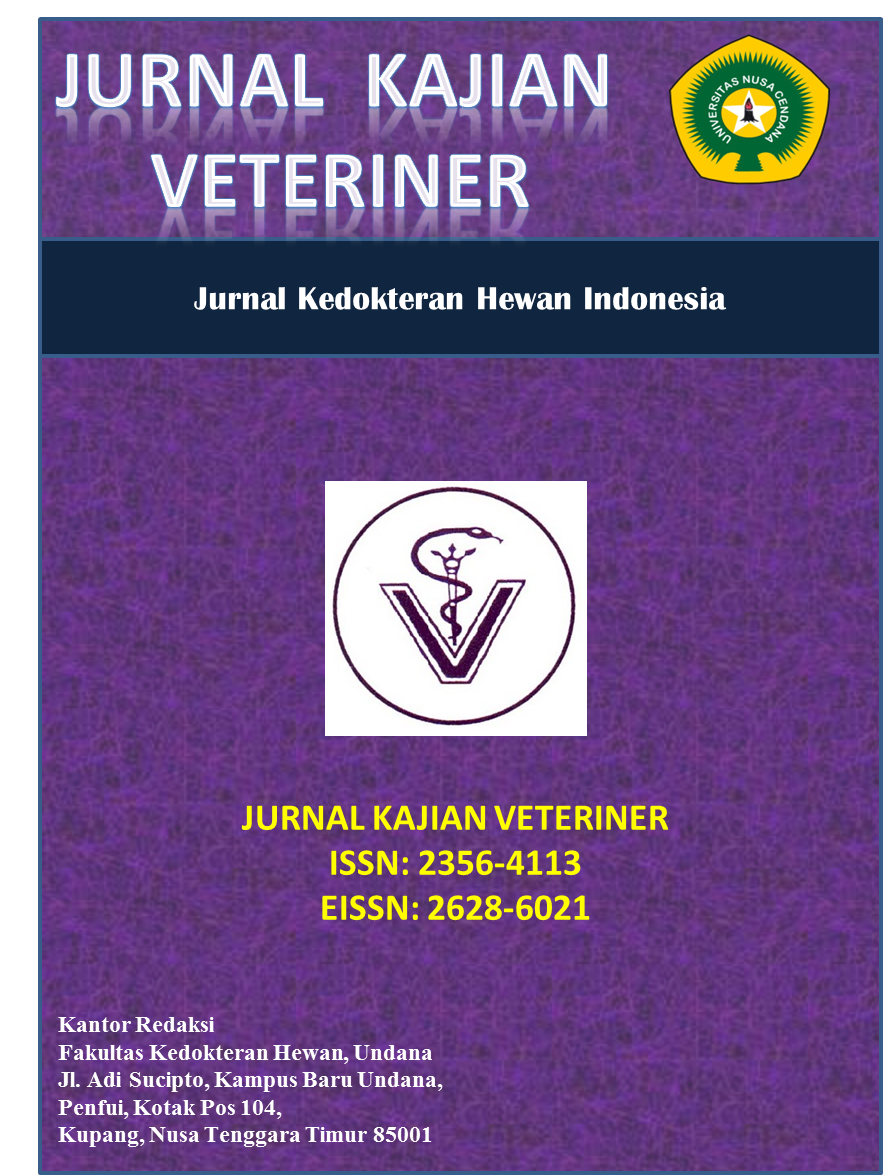KARAKTERISTIK BAKTERI ASAM LAKTAT YANG DIISOLASI DARI SUSU KUDA SUMBA
Characteristics of Lactic Acid Bacteria from Sumba Mares Milk
Abstract
The purpose of this study was to isolate and identify the lactic acid bacteria found in Sumba mares milk. This research will be carried out from September to November 2017 at the Veterinary Laboratory of the Livestock Service Office of East Nusa Tenggara Province. The research stages are isolation of lactic acid bacteria from Sumba mares milk by growing lactic acid bacteria on MRS agar media, and identifying lactic acid bacteria with gram staining, catalase test, motility test, and total plate count testing. Based on the results of the study, the presence of lactic acid bacteria originating from Sumba mares milk was characterized by the presence of colonies of lactic acid bacteria from Sumba mares milk which grew on MRS media agar as a selective medium for lactic acid bacteria. Based on the results of testing the characteristics of lactic acid bacteria Sumba mares milk has Gram positive, the negative results in the catalase test are characterized by not forming gas bubbles when the bacteria are added with H2O2. Based on the motility test obtained negative results or bacteria are non-motile and the number of lactic acid bacteria that can be a total picture of lactic acid bacteria that exist in Sumba mares milk in milliliter of milk. The conclusion are lactic acid bacteria isolated from Sumba mares milk has characteristic as Gram positive, basil or stem shaped, negative catalase and non motile, and has a total lactic acid bacteria of 3.5 x 108 cfu/ml (est).
Downloads
References
Detha A, Datta FU, Beribe E, Foeh N, Ndaong N. 2018. Efektivitas Bakteri Asam Laktat yang Diisolasi dari Susu Kuda Sumba terhadap Kualitas Silase Jerami Padi. Jurnal Kajian Veteriner 6(1): 31-37.
Detha A, Sudarwanto M, Latif H, Datta FU, Latif P. 2013. Fractionation and Identification Antimicrobial Activity of Sumba Mare’s Milk Protein Against Subclinical Mastitis Bacteria in Dairy Cattle. Global Veterinaria 11(5): 674-680.
Detha A, Sudarwanto M, Latif H. dan Datta F. 2014, Komposisi Kimiawi dan Fraksinasi Protein Susu Kuda Sumba. Jurnal Veteriner 15 (4):506-514.
Hasrul SN. 2005, Pembentukan Asam Organik oleh Isolat Bakteri Asam Laktat Pada Media Ekstrak Daging Buah Durian (Durio zibethinus Murr). Journal Bioscientiae 2(1):15-24.
Ibrahim A, Fridayanti A, Delvia F. 2015, Isolasi dan Identifikasi Bakteri Asam Laktat (BAL) dari Buah Mangga (Mangifera Indica L.). Jurnal Ilmiah Manuntung 1(2):159-163.
Rattanachaikunsopon P, Phumkhachorn P. 2010. Lactic acid bacteria: their antimicrobial compounds and their uses in food production. Annals of Biological Research, 1(4): 218-223.
Rolfe RD. 2000, The Role of Probiotic Cultures in the Control of Gastrointestinal Health. Jurnal of Nutrition. 130: 396-402.
Roos N M dan Katan MB. 2000, Effect of Probiotic Bacteria on Diarrhea, Lipid Metabolism, and Carcinogenesis: A Review of Papers Published between 1988 and 1998. Journal of Clinical Nutrition 71:405-411.
Sinlae RN, Suada IK dan Sampurna IP. 2014, Kualitas Susu Kuda Sumbawa pada Penyimpanan Suhu Ruang. Buletin Veteriner Udayana 6 (2):93-97
Sujaya N, Ramona Y, Widarini NP, Suariani NP, Dwipayanti NMU, Nocianitri KA. 2008, Isolasi dan Karakterisasi Bakteri Asam Laktat dari Susu Kuda Sumbawa. Jurnal Veteriner 9 (2) :52-59
Surono IS. 2004, Probiotik Susu Fermentasi dan Kesehatan. PT. Tri Cipta Karya. Jakarta.
Copyright (c) 2019 JURNAL KAJIAN VETERINER

This work is licensed under a Creative Commons Attribution-NonCommercial-NoDerivatives 4.0 International License.

 Annytha Detha(1*)
Annytha Detha(1*)








.png)


